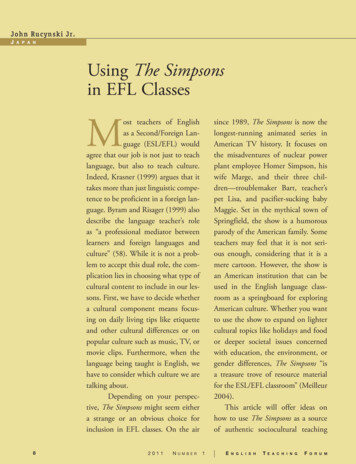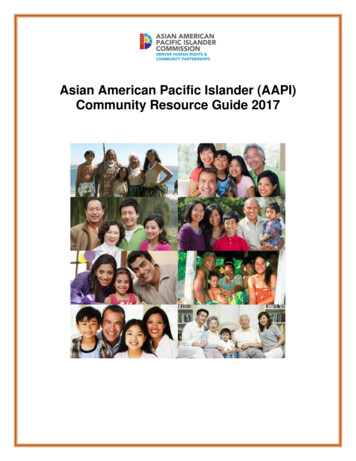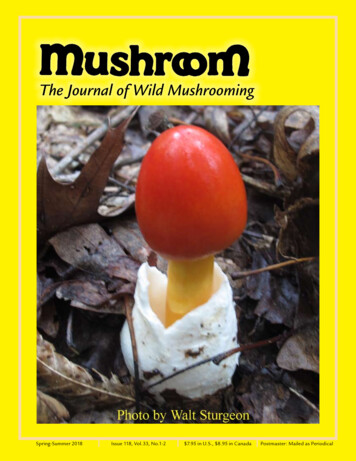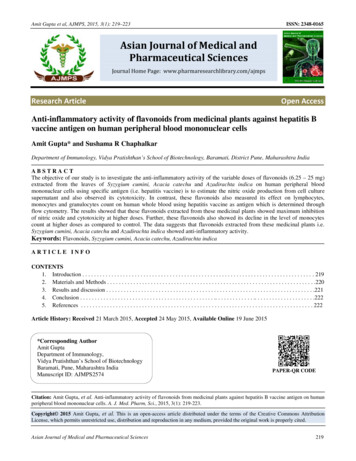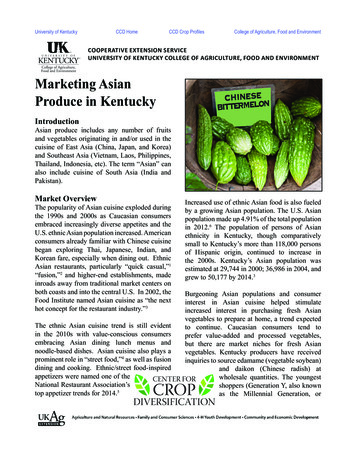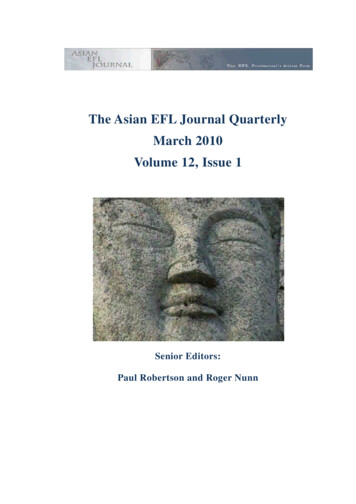
Transcription
The Asian EFL Journal QuarterlyMarch 2010Volume 12, Issue 1Senior Editors:Paul Robertson and Roger Nunn
Published by the Asian EFL Journal PressAsian EFL Journal PressA Division of Time Taylor International LtdTime Taylor CollegeDaen dongBusan, Koreahttp://www.asian-efl-journal.com Asian EFL Journal Press 2010This book is in copyright. Subject to statutory exceptionno reproduction of any part may take place withoutthe written permission of the Asian EFL Journal Press.No unauthorized photocopyingAll rights reserved. No part of this book may be reproduced, storedin a retrieval system or transmitted in any form or by any means,electronic, mechanical, photocopying or otherwise, without the priorwritten permission of the Asian EFL Journal.editor@asian-efl-journal.comPublisher: Dr. Paul RobertsonSenior Associate Editors: Dr. Roger NunnJournal Production Editor: Wen-chi Vivian Wu & Margaret HearndenISSN 1738-14602
Table of Contents:ForewordbyRogerNunn . 1.Mojtaba Maghsodi . -2.3.30-46Active and Passive Vocabulary Knowledge: The Effect of Years of InstructionJeng-yih Tim Hsu . .-8-29Type of Task and Type of Dictionary in Incidental Vocabulary AcquisitionAzadeh Nemati . -5-747-87The Effects of Collocation Instruction on the ReadingComprehension and Vocabulary Learning of Taiwanese College English Majors4.Faith A. Brown . -88-133Vocabulary Knowledge and Comprehension in SecondLanguage Text Processing: A Reciprocal Relationship?5.Colin McDonald, BA, MEd . . .-134-164A pre-trial collection and investigation of what perceptionsand attitudes of Konglish exist amongst foreign and KoreanEnglish language teachers in terms of English education in Korea.6.Indika Liyanage, Peter Grimbeek, & Fiona Bryer -165-180Relative cultural contributions of religion and ethnicity tothe language learning strategy choices of ESL studentsin Sri Lankan and Japanese high schools7.Chi Cheung Ruby Yang . . .-181-201Teacher Questions in Second Language Classrooms:An Investigation of Three Case Studies8.Long Van Nguyen . .-202-233Computer Mediated Collaborative Learning withina Communicative Language Teaching Approach:A Sociocultural Perspective9.Mansoor Tavakoli . .-234-260Investigating the relationship between Self-assessmentand teacher-assessment in a academic contexts:A Case of Iranian university students3
10. Lisha Wang . .-261-284An investigation of the Current State of College Teachers'Teaching Quality and Teacher DevelopmentBook Reviews1. A synthesis of research on second language writing in EnglishIlona Leki, Alister Cumming, & Tony SilvaReviewed by Pisarn Bee Chamcharatsri 285-2872. From Corpus to Classroom: Language Use and Language Teaching .288-289Anne O'Keeffe, Michael McCarthy, and Ronald CarterReviewed by Ruth Breeze3. E-Learning initiatives in China: Pedagogy, policy and culture 290-291Helen, Spencer-Oatey (Ed.)Reviewed by Lisa CheungAsian EFL Journal editorialinformationandguidelines . .292-3014
ForewordWe are happy to present another issue with a varied array of papers from a wide variety ofsettings and cultures. The longer I have been involved in AEJ editing, the more I have cometo realize how broad the field is and how many different valid approaches can be appliedeven within one area of interest. The first five papers all investigate vocabulary acquisition,but from very different perspectives and using very different approaches.Vocabulary papersUse of bilingual dictionaries is common in many Asian contexts. In Type of Task and Type ofDictionary in Incidental Vocabulary Acquisition, Mojtaba Maghsodi investigates the effectof form-oriented comprehension and form-oriented production tasks on incidentalvocabulary acquisition in relation to the use of either monolingual or bilingual dictionaries.The result indicated that subjects using monolingual dictionaries (English to English)retained vocabulary better irrespective of the gender or bilinguality of the subjects.Azadeh Nemati (Active and Passive Vocabulary Knowledge: The Effect of Years ofInstruction) investigates the relationship between two types of English vocabularyknowledge (passive and controlled active) after different periods of school instruction in anESL environment. The results showed that although students progressed in active andpassive vocabulary knowledge, this progress was not significant for controlled active afteryears of instruction, while it was significant for passive vocabularies at higher levels. Nematiconcludes that there is a need to incorporate more active methods for teaching vocabularyand to use instruments that can better test and activate the active knowledge of students.In The Effects of Collocation Instruction on the Reading Comprehension and VocabularyLearning of Taiwanese College English Majors, Jeng-yih Tim Hsu investigates the impact ofexplicit collocation instruction on general English proficiency, listening, speaking, writing,reading, and lexical fluency. The findings indicate that collocation instruction improvesvocabulary learning and retention more than reading comprehension regardless of academiclevel.Faith Brown (Vocabulary Knowledge and Comprehension in Second Language TextProcessing: A Reciprocal Relationship?) considers the relationship between vocabulary5
knowledge and reading comprehension in the reading of expository texts. The findingsreveal a reciprocal relationship between vocabulary knowledge and reading comprehensionin this context and underline a need for strategic reading instruction that emphasizes theexploitation of holistic aspects of language such as context to assist learning.In a study that links culture and vocabulary, Colin McDonald and Scott McRae (A pre-trialcollection and investigation of what perceptions and attitudes of Konglish exist amongstforeign and Korean English language teachers in terms of English education in Korea)discuss the perceptions that foreign and Korean English teachers have of Konglish inrelation to English education in Korea. Konglish refer to English loan words commonly usedin Korean. This phenomenon is not unique to Korea and raises interesting issues aboutteaching English as an international language. McDonald and McCrae help develop anunderstandingofbothgroupsofteachers’view ofKonglishinrelationtoissuesofidentityand ownership and discuss the need to make informed judgments concerning the exploitationof Konglish in the classroom.Other papersAnother important cultural issue is addressed by Indika Liyanage, Peter Grimbeek, & FionaBryer in Relative cultural contributions of religion and ethnicity to the language learningstrategy choices of ESL students in Sri Lankan and Japanese high schools. They consider therelationship between ethnicity and religion on the use of metacognitive, cognitive, andsocial-affective strategies. In a composite sample of four ethnic groups: Sinhalese, Tamil, SriLankan Muslim, and Japanese which included Buddhists, Muslims and Hindus, they foundthat choices of learning strategies appeared to be associated with religious rather than ethnicidentity. Naturally this is a very sensitive issue and the authors point out that care must betaken about drawing categorical conclusions about the extent to which language learningstrategies might be cultural in nature and the need to allow for specific s affiliations.In Teacher Questions in Second Language Classrooms: An Investigation of Three CaseStudies, Chi Cheung Ruby Yang investigates the effects of the types of questions zesthatitisthestudents’responsesthataremore important than the questions and that one cannot be studied without the other. In theteacher training context Yang underlines the need to develop the ability to follow upresponses with moves that encourage students to expand and develop their responses.Mansoor Tavakoli, in Investigating the relationship between self-assessment andteacher-assessment in academic contexts: A Case of Iranian university students,6
investigates the relationship between performance testing and alternative assessment.The findings appear to indicate that self-assessment can be conducted reliably and thatauthenticity is enhanced by using such alternative approaches.Long Van Nguyen (Computer Mediated Collaborative Learning within aCommunicative Language Teaching Approach: A Sociocultural Perspective) discussesthe roles of computer mediated collaborative learning within a communicative languageteaching approach. Nguyen concludes that CMCL is capable of resolving some issuesrelated to the CLT approach in the Vietnamese language classroom. We feel that thisstudy is of relevance in other Asian contexts.Lisha Wang (An Investigation of the Current State of College Teachers’Teaching Qualityand Teacher practiceandthetheoriesunderlying their practice in the current college English education process in China. Wangsuggests the promotion of educational reform by encouraging reflective teaching and thecombined use of teaching practice and research.Roger Nunn,Chief Editor7
Type of Task and Type of Dictionary in Incidental Vocabulary AcquisitionMojtaba MaghsodiAbstractIn this study, the effect of form-oriented comprehension and form-oriented production taskson incidental vocabulary acquisition in terms of using either monolingual or bilingualdictionaries and also considering the gender and the bilingual nature of the subjects wasinvestigated. To meet the aim, 161 Iranian EFL university students were invited to read atext including twelve unknown target words and complete the above-mentioned tasks. Thesubjects were informed that they were allowed to consult the pre-assigned dictionaries inorder to look up the meaning of the target items. The results of the immediate and delayedvocabulary tests revealed that subjects using monolingual dictionaries (English to English)yielded better results in retention of the words irrespective of gender and bilinguality of thesubjects.Keywords: Incidental words, Retention, bilingual nature and gender.1. BackgroundThe crucial role that lexis plays in second or foreign language learning and teaching has been8
repeatedly acknowledged in theoretical and empirical vocabulary research. Hence, Singleton(2007) states that "the major challenge of learning and using a language -whether as L1 or asL2- lies not in the area of broad syntactic principles, but in the 'nitty-gritty' of the lexicon"(Singleton as cited in Murcia, 2007), an idea also shared by Hunt and Beglar (2005), whoargue that "the heart of language comprehension and use is the lexicon" (p. 2). Other authorshave gone even further in arguing that "the single most important task facing languagelearners is acquiring a sufficiently large vocabulary" (Lewis, 2000, p.8), or that "the moststriking differences between foreign learners and native speakers is in the quantity of wordseach group possesses" (Laufer, 1998, p.255).In the early stages of instructed foreign language acquisition, students mainly learn a fewthousand high frequency words. Such words occur so frequently in the teaching materials towhich they are exposed that many are easily acquired. However, a vocabulary size of 2000words is inadequate for functional language proficiency. To take reading as an example,estimates of the number of words required for understanding specialized texts vary, but thereis general consensus that 5,000 base words is a minimal requirement (Laufer, 1997; Nation,1990) while for non-specialized academic reading a wider range of vocabulary is considerednecessary (Groot, 1994; Hazenberg & Hulstijn, 1996). Incidental acquisition of these wordsis only possible to some extent, because they do not occur often enough in the foreignlanguage learning material.There is no doubt that virtually all second language learners and their teachers are wellaware of the fact that learning an additional language involves the learning of large numbersof words (Avila & Sadoski, 1996; Laufer & Hulstijn, 2001), but how to accomplish this taskis often of great concern to them. How vocabulary is acquired and the most efficient meansto promote effective acquisition have been areas of unease in the field of second languageacquisition (De La Fuente, 2002, p.82). All in all, they all place emphasis on the fact that9
mastery of vocabulary is an essential component of second language acquisition.Most research to date underlines high correlations between measures of readingcomprehension and vocabulary knowledge and indicates that gains in one relate to gains inthe other (Beck, McKeown & Omanson, 1987). Reading is seen as the major vehicle msthatintroducingareading‘flood’where learners are motivated and focused on meaning leads to measurable gains invocabulary knowledge. A good deal of vocabulary learning through reading is on to learn words on the part of the learner (Elley & Mangubhai, 1983; Krashen, 1989as cited in Wesche & Paribakht, 1999).1.2. Incidental and Intentional Vocabulary AcquisitionAlthough it seems difficult to guess the meaning of all unknown words from the context,people do manage to learn vocabulary in both their native and foreign languages. Thequestion that arises at this point, then, is how does this process take place? One view is thatlearning can be divided into incidental learning and intentional learning. Intentionalvocabulary acquisition involves memorizing straightforward terms with their respectivetranslations from a list. Learning is quick and therefore, usually preferred by learners, but itis also superficial. Learners encounter vocabulary in an isolated, often infinitive form andremain incapable of using it correctly in context. Didactically recommendable vocabularyacquisition exposes learners comprehensively to every term, embedding them deeply andsolidly in the mental lexicon. Incidental vocabulary acquisition, through contextualdeduction in target language reading, meets these recommendations. Learners encounterterms together with syntactic information, which helps them to use words accurately in heminthelearners’minds.Nation10
(2001) defines learning from context as:the incidental learning of vocabulary from reading or listening to normal ionisonthemessageofthetext.Learning from context thus includes learning from extensive reading, learning fromtaking part in conversations, and learning from listening. Learning from context doesnot include deliberately learning words and their definitions or translations even ifthese words are presented in isolated sentence contexts (Nation, 2001, pp.232-233).1.3. Type of dictionary: Bilingual or monolingual?There are three types of dictionaries; bilingual, monolingual, and bilingualized. These can befound in either paper or electronic form. Both bilingual and monolingual dictionaries havetheir unique strengths and weaknesses for developing vocabulary knowledge.Hunt & Beglar, (2005) believe that apart from having short and easy-to-understanddefinitions, the strengths of bilingual dictionaries lie in the fact that:a) they can improve the reading comprehension of lower proficiency L2 learnersb) they assist vocabulary learning at all levels of proficiencyc) they encourage translationd) they foster one-to-one precise correspondence at the word level between twolanguages.However, the insufficiencies of these kinds of dictionaries relate to the limited informationthey provide of L2 words, and more problematically, the focus on LI and L2 equivalentswhich gives learners the wrong message that there are perfect equivalents in two languages,11
thereby failing to raise awareness that different languages may have different semantic andstylistic can be usedto buildand elaboratealearner’svocabulary knowledge using up-to-date and reliable sentence examples drawn from corpusdata that provide information about meaning and grammar. Generally, the monolingual entrycan also provide more detailed and precise information about idiomatic usage, commoncollocations and connotations.The main disadvantage of these kinds of dictionaries is that students who are less proficientin the L2 may not be able to benefit much from them. Nevertheless, "most authors agree thatthe advantage of the monolingual English learner's dictionary in terms of its reliance on thetargetlanguageoutweighsthedisadvantage[ .]andthedeliberatelysoughtsemantic,grammatical and stylistic explicitness allows-even encourages-productive activities"(Hartmann, 1992, p. 153).Since a combination of the good features of both types of dictionaries can help to clarify tosome extent the aforementioned weaknesses, bilingualized compromise dictionaries cameinto existence. A bilingualized entry typically includes L2 definitions, L2 sentenceinformation and L1 synonyms of the headword. These combination type dictionariesessentially provide translations, in addition to, the good features of monolingual dictionaries.Using bilingualized dictionaries is more efficient than using separate bilingual andmonolingual dictionaries. They are more flexible. Beginning and intermediate learners canrely on the L1 translation and advanced learners can concentrate more on the L2 part of theentry (Gu, 2003; Hunt & Beglar, 2005; Laufer & Hadar, 1997).Researchers are interested in investigating the role dictionaries play in the learning ofsecond or foreign language vocabulary. The lively debate amongst language teachers has12
always been whether dictionaries should be used in foreign language classrooms, and if so,what type of dictionaries should be used. Presently, there is a common view that EFLteachers should discourage studentsfrom ictionary use can lead to word for word reading (Chin, 1999, p.3).In the words of Chun & Plass (1996) and Lyman-Hager & Davis (1996), one of the mostcommon word-focused activities used during reading is consulting a gloss or a dictionary.Glosses and dictionaries are used by learners to facilitate comprehension, but their use cancontribute to small increments in vocabulary learning as well. For example, Luppescu & Day(1993) found that students using a dictionary during reading gained higher scores on a posttest than those who did not.2. The study2.1. AimThe aim of the present study is to explore the impact of bilingual and monolingualdictionaries on the retention of unfamiliar words irrespective of types of tasks, (i.e. messageoriented and form-oriented tasks). The other purposes of the current study are to characterizethe interaction between gender and bilinguality of the subjects and retention of thereforetofindoutwhetherdifferentkindsof dictionaries affect incidental vocabulary acquisition and if they do, to explain which ofthese associates with positive consequences in retention of unfamiliar words.2.2. SubjectsThe researcher in this study used non-probability sample designs (Cohen, 1998) to select thestudent population for this thenon13
probability equivalent of stratified sampling (Nachmias & Nachmias, 1981), was used. Inorder to ensure representativeness of the sample, in relation to the population, students' fieldof study was used as an important criterion for sampling. The subjects were 161 Iranian EFLuniversity students, selected from a pool of over 300 students in Teacher Training Center(TTC), public and Payamnoor universities. The potential moderator variables such as ageand gender were controlled. The subjects were both male and female and their ages rangedfrom 22 to 28 years. They were all undergraduates majoring in the English language.It is worth noting that of the original cohort, the data from twenty-three subjects wereexcluded as a result of being absent for the delayed post-test. The final sample size was 138.The participants were finally categorized into two groups: Group A (87 male/femalemonolinguals), who were able to use just Persian as a language at home or external to that;Group B (74 male/female bilinguals) who used Turkish and Persian as a first and secondlanguage respectively. Subjects were randomly assigned to use either monolingual orbilingual dictionaries2.3. Materials2.3.1. Reading passageTo ensure that the reading passage was an appropriate one in terms of text difficulty levelthat would allow general comprehension, some passages were randomly selected and then areadability formula was run afterward to obtain an index of readability for them. The meanindex turned out to be 22.83. The readability formula, after studying many texts, was thenrun for the above-mentioned texts, which turned out to be 23.7 and seemed quite suitable forthe purpose of this study.As the aim of the present study was to stimulate vocabulary retention following the use of14
dictionary resources, careful consideration was given to the length and density of unknownvocabulary in the text. Hu and Nation (2000) suggest that the learner may reach an adequatecomprehension level of a text at a density of 98% known vocabulary, but that in the intensivereading of short passages, less than 95% coverage may be suitable for developing languageand the use of reading strategies. The text used in the present study, therefore, included 91%of words, which were assumed to be familiar to the learners. This density was regarded asbeing at an appropriate level to enable the learners to be sufficiently challenged so as to wantto use the dictionary resources.2.3.2. Target wordsThe text contained twelve words, including four nouns, four adjectives and four verbs, all ofwhich were unlikely to be familiar to the subjects. This was verified in a pilot test in whichfourteen students of a similar English proficiency who had not participated in the experimentwere asked to underline any words in the passage that they did not know the meaning of. Thetwelve target words were the only words that were underlined in the text and the studentswere requested to focus on them. These words were indigenous, arduous, boisterous,stunning, affability, dusk, itinerary, remuneration, resurrects, toiling, squander and saunter.2.3.3. hesubjects’attentiontoeachofthetwelve target words in a different manner. The researcher encouraged the subjects to clear upany doubts they had in completing the tasks, and were provided with the necessaryinformation to assist with this.In task 1, the learners had to select the meaning of underlined words from four options,15
which were high frequency words. Example 1 illustrates this task:1- In line 3 arduous means .a) kindb)strictc) hardd) observableAs can be seen from this task, attention is drawn to the word itself, rather than to thecontext surrounding it. Hence, this task is called a form-oriented task.In task 2, a synonym or paraphrase of the practiced word was provided and the learners hadto select its corresponding word form from four options, which consisted of the correct targetword and three distracters selected from the twelve target words. This task is called a formoriented production task. Example 2 illustrates this task:2- Which word means to waste?a) itineraryb) arduousc) saunterd) squander2.4. Research QuestionsThe following research questions were addressed in this study:1. Do learners acquire different numbers of words using monolingual or bilingualdictionaries as reflected in the result of an immediate test (a), and as reflected in theresult of a delayed test (b)?2. Is there differential gain for mono and bilinguals after intervention in immediateand delayed post-tests?16
3. Is there differential gain for male and female subjects after intervention in immediateand delayed post-tests?2.5. ProcedureIn the process of carrying out the study, the researcher took the following procedures toachieve its objectives. All the procedures including the development of the backgroundquestionnaire, pre-test, reading for general meaning, task performance, immediate post-test,delayed post-test and their administration are explained in detail below:In the first step of the research, a background questionnaire was developed in order to elicitsome personal information from subjects on their bi / monolingual status, gender and age. Onthe basis of their answers to item 6 (‘The language or languages that you use in and out ofhome’) in the questionnaire, the subjects were first divided into two groups; monolingual-if asubject was able to use just Persian in communication whether at home or external to that,he/she was classified as a monolingual, and bilingual- if a subject was able to use eitherTurkish (as a first language) or Persian (as a second language) in communication, he /shewas classified as a bilingual. A pre-test was then administered in which twelve words werelisted in alphabetical order and participants were asked to give the meanings of any wordsthey knew in English or Persian. In the third step, a text in which the target words wereinserted in bold font was given to the subjects to read so as to understand the generalmeaning of the text. After a couple of minutes, the subjects, who were randomly assigned touse either bilingual or monolingual dictionaries, were asked to complete the respective tasks.It may be worth mentioning that the subjects were informed that in the event of anydifficulties with the meanings of the target words, they were requested to consult dictionariesthey were provided with in order to ascertain their meanings. The subjects were prohibitedfrom writing the meanings of the target words in their notebook or on a piece of paper while17
they were completing the tasks, since the aim of the present study was to test retention ofincidental words while using mono or bilingual dictionaries.Once the tasks were completed, the subjects were to give the meaning of each word eitherin English or Persian immediately in a so-called immediate post-test. Hence dinthestudyastheabilitytorecallaword’smeaning in L1 or L2. The above test was repeated 10 days later without advanced warning inorder to check the retention of the words in a delayed post-test.2.6. Data analysisHaving collected all data from the pre-tests, immediate and delayed post-tests, SPSS forWindows (version 14-evaluation version) was employed to calculate the impact of type ofdictionary use, gender and bilingualism on the retention of incidental words. As mentionedpreviously, the main aim of this study was to identify how many of these twelve target wordscould be retained by the subjects. Therefore, a score of 0 was given for an incorrect orunattempted answer and a score of 1 was given for a correct answer. Spelling and minorgrammatical errors such as punctuation were disregarded as the main focus of the study wason the ability to recall the meaning of a word.Having administered the pre-test, those subjects who knew more than two target wordswere excluded. Therefore, in the event there were subjects who knew two words, their scoreswere adjusted accordingly by converting them from 10 (instead of 12) to a percentage grade.The immediate and delayed post-tests provided data on incidental learning of the targetwords. The maximum raw score on each of the tests could be 12 if all twelve words had beenretained.18
3. Results and Discussion3.1. The first hypothesis*Learners acquire different numbers of words using monolingual or bilingual dictionaries (a)as reflected in the result of an immediate test, and (b) as reflected in the result of a delayedtest.Before subjecting the data to repeated measure ANOVA to establish matching andrandomization group, an independent sample‘t’testwasemployedtoseewhethertwogroups differ from each other. The ‘t’-test revealed a non-significantvalue(‘t’ .158;P .876), confirming the matching of groups in the pre-test situation.A significant increase in the mean scores was observed from pre to immediate post-testsituations (F 206.620) and a decrease from immediate post to delayed post-testconditions was observed irrespective of the groups. In the pre-test, the mean score was0.56, which was increased to 10.26 in the immediate post-test and later decreased to 6.74.However, when group-wise changes were verified, again differential changes nglishtoEnglish’groups,whichwasstatistically significant (F 6.129; P . 004). From the mean values, it is evident that in the‘EnglishtoPersian’group,thepre-test mean score was 0.58, which was increased to10.83 in the immediate EnglishtoEnglish’group,thepre-test mean score was 0.53, which was increased to 10.15 in theimmediate post-test and later decreased to 7.47. From Table 1 and Figure 1, it is clear19
roupthanthe‘EnglishtoPersian’one.Table 1Mean scores of mono and bilingual subjects in different groups for pre, immediate post anddelayed post-tests.GROUPSLINGUALITYConditionsPreE to PE to ETotalImmediate PostDelayed Total0.560.8010.262.196.743.22E to P English to PersianE to E English to EnglishTable 2Results of repeat
Dictionary in Incidental Vocabulary Acquisition, Mojtaba Maghsodi investigates the effect of form-oriented comprehension and form-oriented production tasks on incidental vocabulary acquisition in relation to the use of either monolingual or bilingual dictionaries. The result indicated that subjects using monolingual dictionaries (English to .


